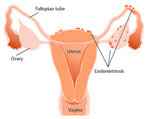Endometriosis is a common condition that affects as many as 2 million women in the UK, and it can causes pelvic pain, irregular bleeding, heavy periods, depression, fertility problems and more.

What is Endometriosis?
 Endometriosis is a condition where the cells that normally line the womb grow outside of the womb, on other pelvic organs such as the ovaries and fallopian tubes. Because they are the same types of cells as those inside your womb, they grow every month and bleed during your period.
Endometriosis is a condition where the cells that normally line the womb grow outside of the womb, on other pelvic organs such as the ovaries and fallopian tubes. Because they are the same types of cells as those inside your womb, they grow every month and bleed during your period.
Because these cells are on the ovaries, fallopian tubes and elsewhere, the blood has nowhere to go, so this causes pain, scarring and swelling on the pelvic organs which can cause a lot of pelvic pain, back pain and fertility problems.
Symptoms of Endometriosis
Endometriosis symptoms vary from person to person, and they depend on how severe the endometriosis is.
- Pelvic pain, pain in the lower abdomen (tummy) or in the lower back
- Heavy or painful periods (menorrhagia)
- Irregular bleeding
- Fertility problems
- Pain during intercourse (dyspareunia)

If you suffer from any of these symptoms and think that you may be suffering from endometriosis, it’s important to see your GP who will be able to run some tests, such as a hysteroscopy (where they look inside your womb with a little camera) to see if endometriosis is present.
Treatment for Endometriosis
Endometriosis treatment depends on how bad the endometriosis is and whether or not you hope to have children in the future. In mild cases, the doctor may recommend things such as painkillers and hormone treatments.
In more severe cases of endometriosis, the doctor may recommend surgery.
- Hysteroscopy: is a procedure used to examine the inside of the womb (uterus). It is carried out using a hysteroscope, which is a narrow telescope with a light and camera at the end. This procedure allows your doctor to diagnose and treat causes of abnormal bleeding.
- Laporoscopy: this is a keyhole surgery technique - doctors will use a tiny camera to look inside the womb, and will use delicate instruments to destroy patches of endometriosis. This is successful in cases of mild endometriosis and has good success rates.
- Hysterectomy: in more serious cases of endometriosis, hysterectomy is sometimes the only option, but it’s only used when other endometriosis treatment options have been exhausted.
If you suffer from chronic endometriosis pain or pelvic pain, you can help your muscles to relax and target pelvic pain with the pain programme on the Kegel8 Ultra – this helps to relax your muscles and on the new Kegel8 Ultra can even be used with skin electrodes if inserting a probe is painful.




